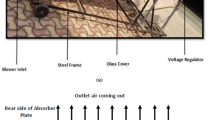Abstract
Heat transfer augmentation features for the improvement of heat transfer from the absorber-plate of a solar air heater to the working fluid are mostly fins however these features also increase pressure drop in the flow channel. The exergy optimization philosophy is adopted in the fin sizing for this air heating application; this optimization philosophy ensures that the maximum quantity of heat is transferred by the fins while generating the least entropy in the system thus conserving exergy. Results indicate that the higher the fin efficiency, the higher the heat conversion and delivery potential. Given an optimum fin length (efficiency) and superior coating absorptive vigour, useful energy losses in the heater can be minimized. Some important observations relevant in design are made.
Similar content being viewed by others
References
Poulikakos, D. and Bejan, A., Fin Geometry for Minimum Entropy Generation in Forced Convection, ASME J. Heat Transfer, 1982, vol. 104, pp. 616–623.
Bejan, A., General Criterion for Rating Heat Exchanger Performance, Int. J. Heat Mass Transfer, 1978, vol. 21, pp. 655–665.
Khan, W.A., Culham, J.R., and Yovanovich, M.M., Optimization of Pin-Tin Heat Sinks Using Entropy Generation Minimization, Thermal and Thermomechanical Phenomena in Electronic Systems, 2004, vol. 1, pp. 259–267.
Dul’kin, I.N. and Garas’ko, G.I., Analysis of the 1D Heat Conduction Problem for a Single Fin with Temperature Dependant Heat Transfer Coefficient - Part II. Optimum Characteristics of Straight Plate and Cylindrical Pin Fins, Int. J. Heat and Mass Transfer, 2008, vol. 51, pp. 3325–3341.
Gereneser, D.S. and Razani, A., Optimization of Radiative - Convective Arrays of Pin Fins Including Mutual Irradiation between Fins, Int. J. Heat Mass Transfer, 1995, vol. 38, no. 5, pp. 899–907.
Rai, G.D., Solar Energy Utilization: A Textbook for Engineering Students, Delhi: Khanna Publ., 2004.
Bejan, A., Heat Transfer, New York: John Wiley and Sons, 1993, pp. 65–69.
Nwosu, P.N. and Onyegegbu, S.O., Effect of Absorptive Coating of the Hot Fluid Passage of a Heat Exchanger Employing Exergy-Optimized Pin Fins in High Temperature Applications, ASME J. Heat Transfer, 2009, vol. 131, no. 5.
Gebhart, B., Heat Transfer, New York: McGraw Hill, 1979, pp. 212–214.
Incropera, F.P. and Dewitt, D.P., Fundamentals of Heat and Mass Transfer, New York: Wiley, 1996
Grimson, E.D., Trans. ASME, 1937, vol. 59.
Zhukaukas, A., Heat Transfer from Tubes in Cross-Flow, in Advances in Heat Transfer, New York: Acad. Press, 1972, vol. 8.
Nwosu, P.N., Heat Transfer Analysis and Computer-Aided Design of a Pin-Fin Heat Exchanger with Internal Coating, M. Eng. Thesis, Nsukka: University of Nigeria, 2005.
Gray, W.A. and Kilham, J.K., Heat Transfer from Flames, London: Elek Sci., 1976.
Author information
Authors and Affiliations
Additional information
The article is published in the original.
About this article
Cite this article
Nwosu, N.P. Employing exergy-optimized pin fins in the design of an absorber in a solar air heather. Appl. Sol. Energy 45, 248–253 (2009). https://doi.org/10.3103/S0003701X09040069
Received:
Published:
Issue Date:
DOI: https://doi.org/10.3103/S0003701X09040069




